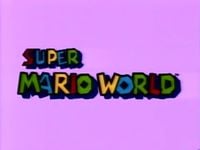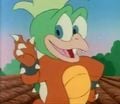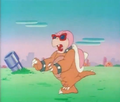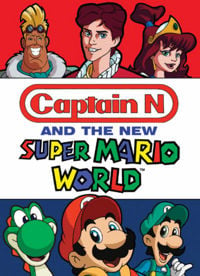Super Mario World (television series)
- This article is about the animated television series. For the game on which it is based, see Super Mario World. For other uses, see Super Mario World (disambiguation).
| Super Mario World | |||||||||||||||
|---|---|---|---|---|---|---|---|---|---|---|---|---|---|---|---|
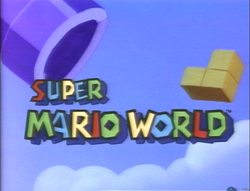 The Super Mario World intro screen | |||||||||||||||
| General information | |||||||||||||||
| Format | Children's television series | ||||||||||||||
| Director | John Grusd | ||||||||||||||
| Opening theme | "Super Mario World Main Title" | ||||||||||||||
| Closing theme | "Super Mario World Main Title" (Instrumental) | ||||||||||||||
| Composers | Michael Tavera Monroe Michaels | ||||||||||||||
| Country of origin | United States of America | ||||||||||||||
| Original language | English | ||||||||||||||
| Translations | Albanian
Arabic Cantonese Croatian French German Greek Hungarian Italian Korean Mandarin Chinese Taiwanese Mandarin Polish Brazilian Portuguese European Portuguese Romanian Russian Latin American Spanish Castilian Spanish Thai Turkish Ukrainian | ||||||||||||||
| Ratings |
| ||||||||||||||
| Number of seasons | 1 | ||||||||||||||
| Number of episodes | 13 | ||||||||||||||
| Production | |||||||||||||||
| Production company | DIC Entertainment | ||||||||||||||
| Distributor | WildBrain[8] | ||||||||||||||
| Runtime | 20–23 minutes | ||||||||||||||
| Broadcast | |||||||||||||||
| First aired | |||||||||||||||
| Last aired | |||||||||||||||
| Status | Ended | ||||||||||||||
| Chronology | |||||||||||||||
| Predecessor | The Adventures of Super Mario Bros. 3 (1990) | ||||||||||||||
| Related programs | Captain N & The Video Game Masters Mario All Stars | ||||||||||||||
Super Mario World is the third and final of DIC Entertainment's animated Super Mario trilogy, loosely based on the game of the same name, premiering a month after its North American release. The cartoon chronicles the adventures of Mario, Luigi, and Princess Toadstool in Dinosaur Land. Yoshi and several new characters, such as Oogtar, a blond-haired caveboy, make appearances as well. Super Mario World originally aired from September 14, 1991, to December 7, 1991.[9] The series has only 13 episodes.
Overview[edit]
Sometime after the events of The Adventures of Super Mario Bros. 3, having banished King Bowser Koopa, the Koopalings, and their minions from the Mushroom Kingdom for good, Mario, Luigi, and Princess Toadstool decide to take a vacation in Dinosaur World. However, King Koopa and his minions manage to follow them there and kidnap the princess yet again. After adventuring and befriending Yoshi, Mario and Luigi manage to rescue Princess Toadstool from King Koopa's Neon Castle and subsequently decide to stay in Dinosaur Land's Dome City with the Cave People.
Several episodes of Super Mario World often have Mario, Luigi, Yoshi, Princess Toadstool, and occasionally Oogtar, a show-exclusive character, trying to stop the schemes of King Koopa and the Koopalings, as well as other villains such as Wizenheimer or the Dino Riders. Toad, who appears in The Super Mario Bros. Super Show! and The Adventures of Super Mario Bros. 3, does not appear in the series (nor does he appear in the game it is based on), making it the only Super Mario cartoon where he does not appear. Because of his absence in the show, he is replaced by both Yoshi and Oogtar, the latter of whom having the same voice actor. Mario, Luigi, Princess Toadstool, King Koopa, and the Koopalings also retain their designs from The Adventures of Super Mario Bros. 3, although the "L" on Luigi's cap is black instead of green in early episodes, Princess Toadstool has lighter skin and blue eyes instead of black eyes, and Cheatsy's hair is light-green instead of dark-blue. Also, Mario and Luigi's Fire forms in the show are based on their Fire form sprites from the game. Walker Boone, Tony Rosato, Tracey Moore, and Harvey Atkin reprise their roles as Mario, Luigi, Princess Toadstool, and King Koopa respectively in the show.
Social issues[edit]
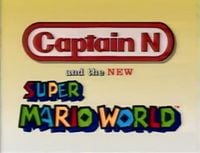
Due to the introduction of the Children's Television Act in 1990, some social commentary and edutainment was added into the series. Some episodes of Super Mario World can be seen as social commentary for controversial issues, such as street gangs ("Born to Ride"), television addiction ("Rock TV"), bullying in school ("A Little Learning"), and obesity and capitalism ("King Scoopa Koopa"). Additionally, several episodes such as "The Wheel Thing" and "Party Line" deal with the introduction and consequences of introducing new concepts and technologies to others without thinking ahead, in these cases, the Cave People of Dome City. One of the more noticeable changes made to the series in light of the CTA is the change made to Princess Toadstool's personality, where she is now more of a role model and parental figure for Mario, Luigi, and Yoshi.
Broadcast history[edit]
This section needs additional citations for verification. Unsourced material may be challenged and removed. Specifics: Information on the show's airing history needs to be corroborated with external sources
Please help improve this section by adding citations from reliable sources.
Super Mario World originally aired alongside Captain N: The Game Master on NBC, where it was referred to as Super Mario Bros. 4 in end credit promos and Super Mario Bros. World in commercial bumpers. Super Mario World is also the only Mario cartoon to air in Australia on Network Ten and Cheez TV, though only on Mondays to Wednesdays on the latter. In both the United Kingdom and Australia, the episode "King Scoopa Koopa" aired before "The Night Before Cave Christmas", due to a mistake involving the show's production order and the production order of Captain N: The Game Master.[15]
Along with Captain N, Super Mario World was one of the last cartoons to air on NBC as that network began to gradually phase out cartoons on Saturdays. Both were canceled by the fall of 1992 and replaced with a Saturday version of Today, along with their TNBC block, which included such shows as Saved by the Bell and California Dreams. In the mid-nineties, the Super Mario World episodes aired on USA Network, without the Captain N episodes.
Due to the nature of its production, Super Mario World is actually one half of a series entitled Captain N and the New Super Mario World, which also consists of the third season of Captain N: The Game Master. Although the "New" suffix was used to promote the Super Mario World game when the show first aired, it is part of the series' proper title, and was never dropped. An episode of this half hour series consists of a Super Mario World episode and either a Captain N episode or a second Super Mario World episode. Due to legal issues, the third season episodes of Captain N and the Super Mario World episodes are inseparable, and have to be released on DVD in the same set. This also explains why the first two seasons of Captain N: The Game Master were released in a "complete series" set; the third season is part of a separate show. The show can also be seen on Starz Encore's Kids and Family channel on weekday afternoons since 2019, as well as on Paramount+, The Roku Channel and NCircle TV in the US.
From 1998 to 1999, the show, along with The Adventures of Super Mario Bros. 3 aired reruns on the PAX KIDS block of the PAX TV channel.[16] These airings had a lower audio pitch than the original episodes, and ended with a safety tip scene from DIC's Inspector Gadget series.[17]
In the United Kingdom, the United States, Australia, and New Zealand, the series is currently airing via the Super Mario Bros. FAST channel on LG Channels, The Roku Channel, and Samsung TV Plus alongside The Super Mario Bros. Super Show! and The Adventures of Super Mario Bros. 3.
- United States
- NBC (1991)
- USA Network (1990s)
- PAX TV (1998–1999)[16]
- Starz Encore (2019–)
- Australia
- Network Ten
- Cheez TV
- KidsCo (2009–2013)
- United Kingdom and Ireland
- Albania
- Croatia
- France
- KidsCo (2006–2013)[21]
- Germany
- Greece
- Hong Kong
- Italy
- Latin America
- Middle East and North Africa
- Portugal
- KidsCo (2009–2013)[28]
- Romania
- KidsCo (2009–2013)[29]
- Russia
- KidsCo (2009–2013)[30]
- Spain
- Taiwan
- KidsCo[32]
- Ukraine
Characters[edit]
Main protagonists[edit]
Main antagonists[edit]
Cast[edit]
The voice acting was recorded in Canada.
- Walker Boone — Mario
- Tony Rosato — Luigi
- Tracey Moore — Princess Toadstool
- Andrew Sabiston — Yoshi
- Harvey Atkin — King Bowser Koopa
- Tara Strong — Hop
- John Stocker — Gophers, Koopa wizard, Oogtar, Wizenheimer
- Tabitha St. Germain — Kootie Pie Koopa
- James Rankin — Cheatsy Koopa
- Dan Hennessey — Bully Koopa, evil dinosaur, Rockman
- Michael Stark — Kooky von Koopa
- Gordon Masten — Big Mouth Koopa
- Judy Marshak — Additional voices
- Catherine Gallant — Mama Fireplant
- Stuart Stone — Hip
Episodes[edit]
| Premiere date | Episode |
|---|---|
| September 14, 1991 | "Fire Sale" |
| September 21, 1991 | "The Wheel Thing" |
| September 28, 1991 | "Send in the Clown" |
| October 5, 1991 | "Ghosts 'R' Us" |
| October 12, 1991 | "The Night Before Cave Christmas" |
| October 19, 1991 | "King Scoopa Koopa" |
| October 26, 1991 | "Born to Ride" |
| November 2, 1991 | "Party Line" |
| November 9, 1991 | "Gopher Bash" |
| November 16, 1991 | "Rock TV" |
| November 23, 1991 | "The Yoshi Shuffle" |
| November 30, 1991 | "A Little Learning" |
| December 7, 1991 | "Mama Luigi" |
Songs[edit]
- Main article: List of Super Mario World (television series) songs
Home releases[edit]
The Super Mario World episode "The Night Before Cave Christmas" was released sometime in 1993 for a VHS tape entitled "Super Mario Bros. Super Christmas Adventures"; along with "Koopa Klaus."
Currently, DVDs of every single Super Mario World episode are available in Australia; the episode "A Little Learning" was also available on a VHS tape for a time in the UK.
Due to complications involving the use of Yoshi, it was originally thought that DVD box sets of Super Mario World were not going to be made. However, those issues were resolved, and Shout! Factory released a box set containing the complete series, along with the third season of Captain N: The Game Master. The DVD was discontinued in 2012, along with The Adventures of Super Mario Bros. 3: The Complete Series and The Super Mario Bros. Super Show Volume 1 and 2, when Cookie Jar Entertainment merged with WildBrain (formerly DHX Media).
As of 2014, the episodes, along with the Captain N segments, have been streamed on WildBrain's YouTube Channel "WildBrain - Cartoon Super Heroes."
Production[edit]
During development, the show's working title was Super Mario Bros. 4, which was the subtitle of the original Super Mario World game, and sported a logo that was edited from Super Mario Bros. 3.[33] Unlike previous Super Mario cartoons where scripts were produced in a three-step fashion (starting with the writer submitting an episode premise to the show's story editors, then a multi-page outline, then the full script), all of the episode premises for Super Mario World were written by the show's story editor Phil Harnage and then assigned to various writers of the previous series for the full script, skipping the outline stage - something that writer Perry Martin noted was "never a good idea."[34]
Staff[edit]
- Main article: List of Super Mario World (television series) staff
As with the previous show, Super Mario World was produced and directed by John Grusd, with DIC president Andy Heyward acting as the executive producer and creative supervisor. Animation was done by the Chinese studio Pacific Rim Productions, Inc. rather than Sei Young Animation Co., Ltd., except for the opening which was done by Canvas, Inc. The series is coproduced by Reteitalia S.P.A. and Telecinco.
Differences from the game[edit]
- The Cave People and Dome City are original locations created for the Super Mario World television series, and do not appear in the actual game.
- Characters retain their color differences from The Super Mario Bros. Super Show! despite Nintendo having redesigned the characters in the Super Mario franchise.
- Like in the The Super Mario Bros. Super Show! and The Adventures Super Mario Bros. Super Show!, Bowser is referred to as King Koopa.
- The Koopalings retain their alternate names from The Adventures of Super Mario Bros. 3.
- The circumstances under which Yoshi emerges from an egg are different. Instead of being trapped in an egg by Bowser in his attempts to rescue his friends, he is a newborn infant.
- The ? Block that activates the spotlight is the standard yellow instead of red.
- Many locations and enemies are referred to by different names, some of which are reminiscent of their Japanese names:
- A Banzai Bill is referred to as a "Magnum Bill."
- Boos are referred to as "ghosts."
- Bowser's Castle are referred to as the "Coney Island Disco Palace" or "Neon Castle."
- Chargin' Chucks were referred to as "Koopa football players."
- What appears to be the Forest of Illusion is referred to as the "Enchanted Forest."
- Magikoopas are referred to as "Koopa wizards."
- Mechakoopas are referred to as "Mechkoopas" or "robots."
- Monty Moles are referred to as "Gophers."
- Power Balloons are referred to as "Magic Balloons."
- Rexes and Dino-Rhinos are collectively referred to as "dinosaurs."
- What appears to be either Spiny Cheep-Cheeps or Porcu-Puffers are referred to as "porcupinefish."
- Star World is referred to as the "Star Path", and the red course marks are depicted as Warp Pipes.
- A Sumo Brother is referred to as a "Fire Sumo."
- The Koopa Clown Car is referred to as the "Flying Clown Head," albeit only in a preview.
- Wigglers are referred to as "caterpillars."
Quotes[edit]
- Main article: List of Super Mario World (television series) quotes
Gallery[edit]
- For this subject's image gallery, see Gallery:Super Mario World (television series).
King Koopa, Princess Toadstool, and 2 Mechkoopas in the Flying Clown Head
Wizenheimer with a Bob-omb
Translations[edit]
This section is about a work that used to be available to the public, but is now partially or entirely inaccessible. Details: Many translations of the show are either partially or entirely lost; see Lost translations section.
Our documentation of the subject is inadequate. Only remove this notice if the complete work is recovered and made available publicly.
The show received 22 translations, including Albanian, Arabic, Cantonese, Croatian, French, German, Greek, Hungarian, Italian, Korean, Mandarin Chinese, Taiwanese Mandarin, Polish, Brazilian Portuguese, European Portuguese, Romanian, Russian, Latin American Spanish, Castilian Spanish, Thai, Turkish, and Ukrainian, as well as a Polish voiceover, with several differences between them:
- The Albanian dub replaces the original logo for the show with a new logo.
- Like in The Adventures of Super Mario Bros. 3, the Arabic dub uses generic cyan title cards to display the title for each episode.
- Like in The Adventures of Super Mario Bros. 3, the Italian uses instrumentals for most songs in the show, with the exception of "Kootie Pie Rap" and "Cheatsy's Life," which the Hungarian dub also does for "Motor City," "At the Circus," "Time to Run," and "Time to Get Wild."
- In the original German dub, the intro sequence uses the "Plumber's Rap" from The Super Mario Bros. Super Show! The German dub also reuses the title card opening from The Adventures of Super Mario Bros. 3, with the curtain rising to display the episode's title.[22]
- The Korean dub features an original song composed for the dub, "Super Mario," played before the original theme song for the show. It also pauses the video briefly at the beginning of each episode to display the title for the episode.
- Like in The Adventures of Super Mario Bros. 3, the Brazilian Portuguese dub replaces the original background music with Isao Tomita's compositions.
- In the Latin American Spanish dub, Yoshi and Oogtar mostly speak complete sentences as opposed to mostly speaking in broken sentences like in the original version.
Lost translations[edit]
Despite the show's wide distribution in a variety of languages, many translations of the show have become partially or entirely lost. Information on missing translations is as follows:
- Cantonese: Only the episode "Send in the Clown" has been found.
- German: Only the title card for "Born to Ride" in the original German dub has been found.
- Greek: The first minute and 58 seconds of the episode "The Yoshi Shuffle," as well as the voiceover introducing the title of "A Little Learning" in the Greek Cine-TV-Video Procutions TV dub, are lost. The Media Palette Greek dub is completely lost.[35]
- Mandarin Chinese: The dub is completely lost. A small clip of the beginning of the episode "The Wheel Thing" from the dub was previously found, but was lost again when the video featuring the clip was removed.[36]
- Taiwanese Mandarin: Only a promotional trailer of the Taiwanese Mandarin dub has been found.
- European Portuguese: The dub is completely lost, with only a overview of the show on the European Portuguese KidsCo website being the only proof of its existence.[28]
- Russian: Only the episodes "Fire Sale," The Wheel Thing," "Party Line," "Gopher Bash," "Rock TV," and "The Yoshi Shuffle" have been found.
- Thai: 42 minutes and 16 seconds of the dub has been found. However, the video is inaccessible outside of Thailand.[37]
- Turkish: Only the first four episodes of the dub have been found.
- Ukrainian: Only an advertisement for the Ukrainian dub has been found.
Names in other languages[edit]
| Language | Name | Meaning | Notes |
|---|---|---|---|
| Albanian | Bota e Super Marios[38] | Super Mario World | |
| Arabic | سوبر ماريو[27] Subar Mariu |
Super Mario | Considered as a continuation of the previous series |
| Croatian | Super Mario Bros. 4[39] | - | |
| French (NOA) | Super Mario World[40] | - | |
| French (NOE) | Super Mario World 4[41] | - | |
| German | Super Mario World[22] | - | |
| Greek | Σούπερ Μάριο[12] Soúper Mário |
"Super Mario," same as The Super Mario Bros. Super Show! and The Adventures of Super Mario Bros. 3 | |
| Hungarian | Super Mario[42] | - | |
| Super Mario Világa[43] | Super Mario World | DVD | |
| Italian | Super Mario[44] | - | First airings |
| Le avventure di Super Mario[45] | The adventures of Super Mario | Subsequent airings, considered as a continuation of the previous series | |
| Korean | 마리오4부[46] Mario 4-bu |
Mario Part 4 | |
| Polish | Nowe przygody braci Mario[47] | The new adventures of the Mario Brothers | TV dub, considered as a continuation of the previous series |
| Fantastyczny świat braci Super Mario[48] | The Fantastic world of the Super Mario Brothers | VHS dub | |
| Portuguese (NOA) | Super Mario Brothers[49] | - | |
| Portuguese (NOE) | O Mundo de Super Mario[28] | Super Mario World | |
| Romanian | Lumea lui Super Mario[50] | Super Mario's world | |
| Russian | Мир Супер Марио[30] Mir Super Mario |
Super Mario's World | |
| Spanish (NOA) | El mundo de Super Mario[51] | Super Mario world | |
| Spanish (NOE) | Super Mario Bros.[10] | - | original dub |
| El mundo de Super Mario[52] | Super Mario world | re-dub | |
| Thai | พี่น้องมาริโอ[37] Phee-naawng Ma-ri-o |
Mario Brothers | |
| Turkish | Super Mario[53] | - | |
| Ukrainian | Супер Маріо[54] Super Marіo |
Super Mario |
Notes[edit]
- The show's background music and sound effects taken from the original game were composed and sampled with the original game's right speaker in mind. This is especially noticeable for the show's arrangements of (including, but not limited to) "Underground BGM" and "Castle BGM," as well as the sampled Warp Pipe and Cape Feather transformation sound effects.
References[edit]
- ^ https://www.imdb.com/title/tt0167552/
- ^ 1990 (2007 DVD) Nintendo Super Mario Bros/World French Francais Coffret 1 & 2
- ^ https://repertoire.cinema.mcc.gouv.qc.ca/film/captain-n-and-the-new-super-mario-world-370445/
- ^ Original VHS Closing: Super Mario World - The Wheel Thing And Other Adventures (UK Retail Tape)
- ^ Captain N and the new Super Mario World + Staffel 3 von Captain N DVD
- ^ https://smb.gportal.hu/picview.php?prt=225345&gid=2889889&index=3
- ^ Super Mario World Volume 1 DVD PAL Region 4
- ^ WildBrain - Library Catalogue 2021. Issuu (English). Retrieved June 29, 2024.
- ^ a b c https://www.tvmaze.com/shows/4301/super-mario-world/episodes
- ^ a b c d https://www.eldoblaje.com/datos/FichaPelicula.asp?id=3672
- ^ a b c https://www.fernsehserien.de/super-mario-world/im-tv/rtl
- ^ a b c d e f Σούπερ Μάριο (1991)
- ^ a b c Анонсы (ТЕТ, март 2005)
- ^ a b 【1993年ATV粤语】孖寶兄弟(Super Mario Brothers- Seno in the Clown)
- ^ Super Mario World Collection Vol 1 2 3 Complete DVD Box Set PAL Region 4
- ^ a b Pax TV Sun 20 Jun 1999
- ^ PAX Kids, June 27, 1999 - Super Mario World, The Adventures of Super Mario Bros. 3
- ^ Super Mario World (Episode 1) - Fire Sale
- ^ Tani në TV
- ^ Super Mario Bros ( 4 Kompilacija ) - Crtani Film
- ^ Super Mario World Le fast food
- ^ a b c Super Mario World Intro deutsch
- ^ https://www.fernsehserien.de/super-mario-world/im-tv/kidsco-tv
- ^ a b c d https://www.antoniogenna.net/doppiaggio/anim/supermario.htm
- ^ Italian intro
- ^ El mundo de Super Mario - El equipo (Español Latino)
- ^ a b سوبر ماريو - سبيس تون
- ^ a b c O Mundo de Super Mario
- ^ Super Mario World Cartoon - Mama Luigi (Romanian dub, KidsCo)
- ^ a b Мир супер Марио. 1 серия.
- ^ https://www.eldoblaje.com/datos/FichaPelicula.asp?id=38438
- ^ KidsCo 6月週末運動特集迎奧運
- ^ http://acetateaddiction.rubberslug.com/gallery/inv_info.asp?ItemID=383833
- ^ Homenick, Brett (September 11, 2018). DO THE MARIO! Perry Martin on Scripting the Cartoon Adaptations of the Super Mario Bros.!. Vantage Point Interviews. Retrieved October 5, 2018.
- ^ Σούπερ Μάριο (1991)
- ^ https://www.bilibili.com/video/BV1ZhzBYCE5L?spm_id_from=333.788.videopod.episodes [dead link]
- ^ a b Super Mario World พี่น้องมาริโอ้ ตอน ละครสัตว์คูป้า (เสียงไทยจากม้วนวีดีโอ มีกระตุกบางช่วง)
- ^ Bota e Super Marios - Episoda 1 | Shitja e zjarrit (Dublimi Shqip, Çufo)
- ^ SUPER MARIO BROS 3 i 4-crtani filmovi na VHS-u
- ^ Super Mario World Coffret 3 DVD (Version française)
- ^ Coffret Super Mario World 4 [FR Import]
- ^ Super Márió Mese_ Tűz És Jég (Magyarul)
- ^ https://smb.gportal.hu/picview.php?prt=225345&gid=2889889&index=3
- ^ Super Mario - Cartone animato sigla (Intro ITA)
- ^ Le avventure di Super Mario - Episodio 1 - Ghiaccio bollente
- ^ Super Mario World Cartoon (Fire Sale) - Korean version
- ^ Kapitan N i nowe przygody braci Mario. Odc. 2 - Płomienna wyprzedaż/Przypadki i wpadki wesołej gromadki
- ^ Super Mario World: Fantastyczny Świat Braci Super Mario 1 (VHS)
- ^ Super Mario World - Venda de Fogo (Dublado)
- ^ May 20, 2015. "Fire Sale", dubbed in Romanian by KidsCo. Odnoklassniki (OK.ru). Retrieved January 4, 2016.
- ^ Súper Mario world (la venta de fuego)
- ^ Super Mario World (Cap.1 - La venta de fuego) español
- ^ Super Mario (1991) Çizgi Film Türkçe Dublaj 4 Bölüm Birden - NOSTALJİ -
- ^ Анонсы (ТЕТ, март 2005)
External links[edit]
- All full episodes of the show officially uploaded on YouTube, courtesy of WildBrain Spark.
- The theme song
